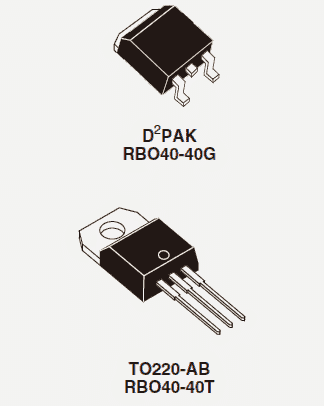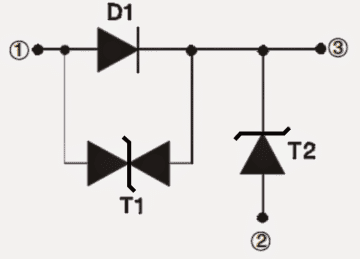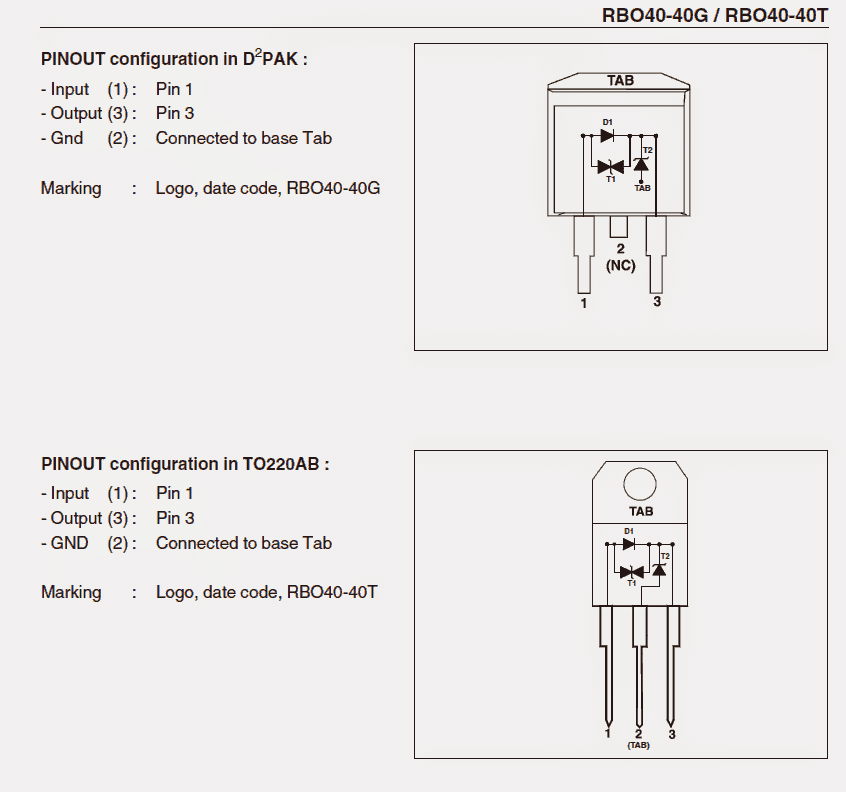In this post we study an outstanding high current diode which features not only an in-built reverse current protection but also an over-voltage protection for safeguarding sensitive electronic circuits against back emfs, transients and load dump occurrences.
How 40 Amp Diode RBO40-40G/T Works
The device RBO40-40G/T from STMicroelectronics comes in a TO-220 package and looks quite like a power transistor, however practically it's designed to work like a rectifier diode rated at a high 40 Amps.


The 40 amp rating itself makes the device immediately suitable for all high current motor and inverter application in the form of a freewheeling diode for countering the dangerous back EMFs, which becomes a serious issue with all such applications.
Although this versatile diode may be ideally suitable as a freewheeling diode and also in the form of blocking diode for safeguarding against reverse battery polarity, the device includes a special over voltage protection for countering voltage surges and load dumps.
As per the datasheet, the device is assigned with the following features:
- In-built spike protector for safeguarding against "load dump" voltage pulses.
- Can be used as regular 40 amp blocking diode for countering accidental battery polarity reversal.
- A Monolithic structure ensures improved reliability
- Breakdown voltage is not above 24V, so here the feature may be restricted within this limit.
- Spike clamping voltage is set at +/- 40V
The absolute maximum ratings of the RBO40-40G/T may be studied from the following data:
- Instantaneous (10ms) non-repetitive surge peak forward current limit is 120Amps
- Continuous DC forward current handling capacity is 40 amps
- Instantaneous peak load dump voltage handling capacity is 80V
- Instantaneous peak power handling capacity is 1500 watts
Internal Layout Description

Referring to the above figure which shows the internal structure of the diode, the involved three main functions of the device may be understood as given under:
1) The indicated diode D1 is assigned for functioning in the standard rectifier diode mode for safeguarding against accidental battery reversal.
2) T2 component associated with the device acts like an effective transil to counter against positive peak transients pulses or back EMFs which may be generated by the associated high power relays, inductors, ignition coils, transformers, motor winding etc.
3) The third part T1 which can be seen in the internal layout of the device is specifically included for motor applications to protect the transistors drivers from the motor coil back EMFs or negative voltage spikes.
Pinout Details
The pinout configuration or the connection details of the proposed 40 amp diode with reverse and overvoltage protection can be seen in the following diagram. Nothing looks complex in the design, it's just about connecting the leads as per the correct polarity, and getting maximum protection from reverse voltage, transients, spikes, over-voltages etc in a circuit which may be highly prone to such parameters.

Courtesy: st.com/web/en/resource/technical/document/datasheet/CD00001320.pdf
Can we use it for transformer dc winding resistance test. Is it protects the test equipments from transformer back emf which is produced during switch of the dc source.pls advice.
It can be used to protect from transformer back EMF but I am not sure whether this diode can be used for transformer DC resistance test or not.
?dl=0" rel="nofollow ugc"> ?dl=0
?dl=0
done changing. can you take a look again? pelase
the diode polarity is incorrect, the band side must be towards the ground.
the S/D is correctly written but the symbol i wrong…you should draw it correctly to avoid confusions.
do not remove the earlier 10V zener, connect it bck across gate/source
?dl=0" rel="nofollow ugc"> ?dl=0
?dl=0
i corrected the drawing of mosfet., and reverse the zener(1n4148)., can you take a look for the last time? please
It looks fine now, but the zener cathode must be connected with the source side of the mosfet
hi swatagam, ?dl=0
?dl=0
i tried my project to protect the battery and solar pannel can you please look at my link?
?dl=0" rel="nofollow ugc">
Hi Kraken, If you are trying to charge the battery from the solar panel and through the MPPT controller, then I am afraid in the shown position the P-channel mosfets will not conduct, because their polarities look reverse biased.
the right side mosfet source should go to the solar panel positive, and the left side mosfet source should go to the MPPT positive.
what could be my solution to protect the mppt from reverse polarity both sides.
interchange the source/drain pins, and connect a 1N4148 series diode between the gates and the ground line, cathode to ground, anode to the 100K resistor.